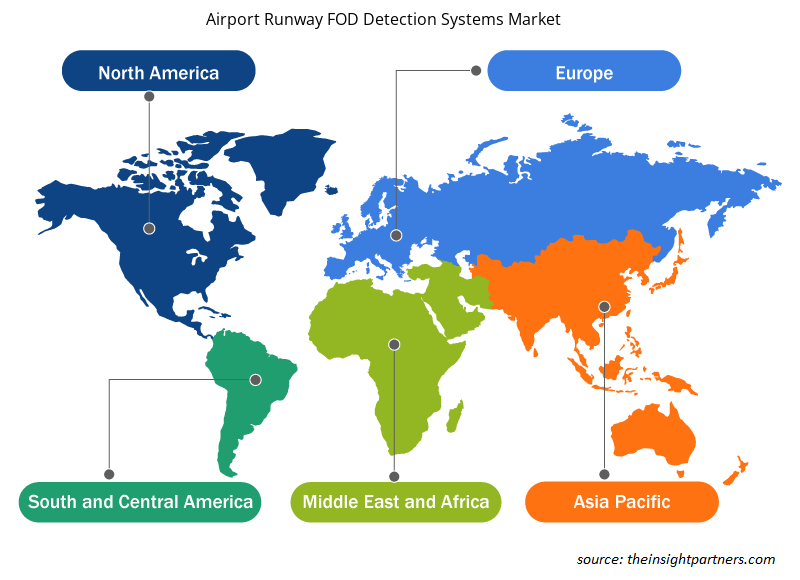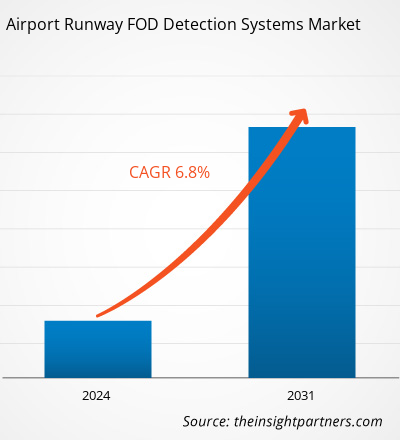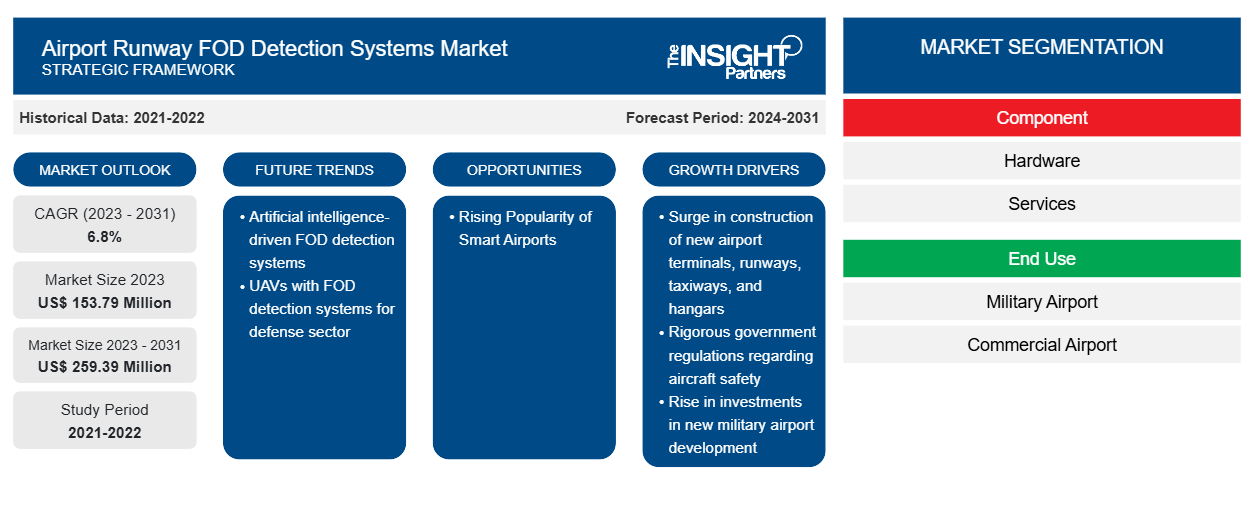机场跑道 FOD 检测系统市场规模预计将从 2023 年的 1.5379 亿美元增至 2031 年的 2.5939 亿美元。预计 2023-2031 年期间市场复合年增长率将达到 6.8%。配备 FOD 检测系统的创新型无人机在国防领域的出现可能会为市场带来新的趋势。
机场跑道 FOD 检测系统市场分析
美国、英国和中国等发达国家的政府正在利用智能机场技术,包括智能传感器、摄像头、通信和网络系统、RFID 标签和可穿戴设备。这是由于机场运营对实时信息的需求不断增长,对尖端连接技术的需求也不断增加。同样,消费者对航空旅行的日益增长的偏好和全球空中交通量的不断增加,正在推动机场跑道 FOD 检测系统在各个民用机场的应用。此外,发达国家国防开支的增加导致军事部门对 FOD 检测系统的采用增加。此外,航空航天和国防工业越来越多地实施云、物联网 (IoT)、区块链和人工智能 (AI) 等先进技术,预计将在未来几年推动机场跑道 FOD 检测系统市场的增长。
此外,FOD 对全球航空业的安全和财务构成了巨大威胁。根据美国联邦航空管理局的数据,全球航空公司和机场每年因 FOD 而承受的损失超过 227 亿美元。这些损失对不同的航空公司和机场也构成了巨大的财务威胁。此外,这些担忧正在推动全球不同机场采用 FOD 检测系统。
机场跑道 FOD 检测系统市场概览
机场跑道 FOD(异物碎片)检测系统主要有助于自动扫描机场表面、滑行道和跑道;提供高检测和分辨率能力;并提供增强的态势感知能力,从而确保用户的安全。政府部门越来越重视建设智能机场,这推动了机场场所对智能技术和系统的集成需求,以实现高效的运营和管理。
定制此报告以满足您的需求
您可以免费定制任何报告,包括本报告的部分内容、国家级分析、Excel 数据包,以及为初创企业和大学提供优惠和折扣
-
获取此报告的关键市场趋势。这个免费样品将包括数据分析,从市场趋势到估计和预测。
机场跑道 FOD 检测系统市场驱动因素和机遇
新机场航站楼、跑道、滑行道和机库建设激增
全球商用飞机机队数量的不断增加是导致不同机场对新航班、航站楼、跑道和机库的需求增加的主要因素之一,以满足全球不断增长的客流量。这推动了机场当局的投资,以升级各自的机场场地,以满足庞大的飞机机队的需求,这也提高了整个机场的运营效率。效率的提高还归功于低成本航空公司的引入,这些航空公司支持了全球航空客运。2023 年 3 月,加拿大基洛纳市议会宣布批准为基洛纳机场航站楼扩建项目提供 9000 万美元的资金。不同国家的几个政府当局也计划在各自的国家建设新机场,以加强国际货运贸易的流动和航空旅行业的发展。例如,在美国,目前正在建设六个新机场。此外,2022 年,印度政府宣布计划到 2025 年底建成约 220 个机场。全国各地正在进行许多项目;例如萨达尔瓦拉巴伊帕特尔国际机场扩建项目、新孟买新国际机场、诺伊达国际机场、坎佩戈达国际机场扩建项目、英迪拉甘地国际机场扩建项目。
2018 年,中国民航局 (CAAC) 宣布计划在 2035 年底前建设约 216 个新机场。该计划可能会使机场总数在 2035 年之前增加到约 450 个机场(2023 年目前为 234 个机场)。2023 年,扬州泰州国际机场 (YTY) 开始扩建项目,以实现和管理 1000 万名乘客、88,670 架飞机起降和每年 50,000 吨货物的目标。此外,2021 年 5 月,关西国际机场 (KIX) 启动了一项扩建项目,重点是每年管理约 4000 万名国际旅客。该项目预计将于 2025 年在关西举行的 2025 年大阪世博会上完工。因此,新机场航站楼、跑道、滑行道和机库的建设有助于机场跑道 FOD 检测系统市场的增长。
智能机场日益普及
政府部门对智能机场的倾向性日益增强,推动了在机场内实施智能系统的需求。由于对实时信息的偏好日益增加,以及机场运营对先进连接技术的需求不断增加,美国、英国和中国等发达国家的政府正在利用智能机场技术,包括通信和网络系统、智能传感器、摄像头、RFID 标签和可穿戴设备。例如,2017 年,新加坡民航局 (CAAS) 和 NATS 有限公司在樟宜机场实施了智能数字塔,这继续增强了监控和通信能力。此外,加拿大政府在 2021-2022 年期间向渥太华国际机场提供了约 1600 万美元的资金,用于修复滑行道 A、M、AA、BB 和 CC 的路面,以及在机场建造轻轨交通站。
机场跑道 FOD 检测系统市场报告细分分析
有助于得出机场跑道 FOD 检测系统市场分析的关键部分是组件和最终用途。
- 根据组件,全球机场跑道 FOD 检测系统市场分为硬件和服务。硬件部分在 2023 年占据了最大的市场份额。
- 根据最终用途,市场分为军用机场和商用机场。商用机场部分在 2023 年占据了最大的市场份额。
机场跑道 FOD 检测系统市场份额(按地区)分析
机场跑道 FOD 检测系统市场报告的地理范围主要分为五个区域:北美、亚太、欧洲、中东和非洲、南美和中美。
北美航空业正在经历重大扩张和发展,以响应该地区日益增长的航空旅行需求和经济活力。包括哈茨菲尔德-杰克逊亚特兰大国际机场、洛杉矶国际机场和达拉斯/沃斯堡国际机场在内的主要机场正在进行现代化项目,以容纳不断增长的客流量。美国拥有世界上最多的机场数量,以及大量机场技术开发商。这使得机场当局更容易采购大量机场技术或系统,包括 FOD 检测系统,从而推动机场跑道 FOD 检测系统市场。国际机场协会 (ACI-NA) 的报告强调,从 2023 年到 2027 年,北美机场基础设施需要 1511 亿美元来维护或扩建。
美国联邦航空管理局 (FAA) 不断努力开发坚固安全的机场和跑道基础设施,这鼓励机场当局投资于 FOD 检测系统等先进技术。因此,FAA 对机场和跑道技术的现代化的巨大需求是推动北美机场跑道 FOD 检测系统市场发展的另一个关键因素。此外,加拿大机场管理局和后续机场管理部门始终强调跑道维护,以防止因跑道事故导致跑道停机。为确保飞机队不断往返机场,机场管理部门正在跑道上安装 FOD 检测系统,这促进了该地区跑道 FOD 检测系统市场的发展。北美机场跑道 FOD 检测系统市场的一些主要参与者包括 Pavemetrics Systems、QinetiQ、Thales Group、Varec, Inc. 和 XSight Systems Ltd. 等。
机场跑道 FOD 检测系统市场区域洞察
Insight Partners 的分析师已详细解释了预测期内影响机场跑道 FOD 检测系统市场的区域趋势和因素。本节还讨论了北美洲、欧洲、亚太地区、中东和非洲以及南美洲和中美洲的机场跑道 FOD 检测系统市场细分和地理位置。

- 获取机场跑道 FOD 检测系统市场的区域特定数据
机场跑道 FOD 检测系统市场报告范围
| 报告属性 | 细节 |
|---|---|
| 2023 年的市场规模 | 1.5379亿美元 |
| 2031 年市场规模 | 2.5939亿美元 |
| 全球复合年增长率(2023 - 2031) | 6.8% |
| 史料 | 2021-2022 |
| 预测期 | 2024-2031 |
| 涵盖的领域 |
按组件
|
| 覆盖地区和国家 |
北美
|
| 市场领导者和主要公司简介 |
|
机场跑道 FOD 检测系统市场参与者密度:了解其对业务动态的影响
机场跑道 FOD 检测系统市场正在快速增长,这得益于终端用户需求的不断增长,这些需求源于消费者偏好的不断变化、技术进步以及对产品优势的认识不断提高等因素。随着需求的增加,企业正在扩大其产品范围,进行创新以满足消费者的需求,并利用新兴趋势,从而进一步推动市场增长。
市场参与者密度是指在特定市场或行业内运营的企业或公司的分布情况。它表明相对于给定市场空间的规模或总市场价值,有多少竞争对手(市场参与者)存在于该市场空间中。
在机场跑道 FOD 检测系统市场运营的主要公司有:
- ArgosAI 技术 A.?
- 穆格公司
- Navtech 雷达
- 路面测量学
- Plextek 服务有限公司
- 莱茵金属股份公司
免责声明:上面列出的公司没有按照任何特定顺序排列。

- 获取机场跑道 FOD 检测系统市场主要参与者概览
机场跑道 FOD 检测系统市场新闻和最新发展
机场跑道 FOD 检测系统市场通过收集一手和二手研究后的定性和定量数据进行评估,其中包括重要的公司出版物、协会数据和数据库。机场跑道 FOD 检测系统市场的一些发展情况如下:
Smiths Detection 加速与 SeeTrue 的合作。Smiths Detection 已成功将 SeeTrue 的技术集成并测试到我们的 CT 安全检查点系统中。Smiths Detection 是威胁检测和安全筛查领域的全球领导者,也是 Smiths Group 旗下的业务,该公司宣布在航空安全技术方面迈出了重要一步。Smiths Detection 与基于 AI 的威胁检测软件提供商 SeeTrue 合作,已成功将 SeeTrue 的技术集成并测试到其先进的 CT 安全检查点系统中,组合解决方案现已准备好立即实施,等待认证。(来源:Smiths Detection,新闻稿,2023 年 10 月)
机场跑道 FOD 检测系统市场报告覆盖范围和交付成果
“机场跑道 FOD 检测系统市场规模和预测(2021-2031 年)”报告对以下领域进行了详细的市场分析:
- 机场跑道 FOD 检测系统市场规模及预测,涵盖范围涵盖的所有关键细分市场的全球、区域和国家层面
- 机场跑道 FOD 检测系统市场趋势,以及驱动因素、限制因素和关键机遇等市场动态
- 详细的 PEST 和 SWOT 分析
- 机场跑道 FOD 检测系统市场分析,涵盖主要市场趋势、全球和区域框架、主要参与者、法规和最新市场发展
- 行业格局和竞争分析,涵盖市场集中度、热图分析、知名参与者以及机场跑道 FOD 检测系统市场的最新发展
- 详细的公司简介
- 历史分析(2 年)、基准年、预测(7 年)及复合年增长率
- PEST和SWOT分析
- 市场规模、价值/数量 - 全球、区域、国家
- 行业和竞争格局
- Excel 数据集
近期报告
客户评价
购买理由
- 明智的决策
- 了解市场动态
- 竞争分析
- 客户洞察
- 市场预测
- 风险规避
- 战略规划
- 投资论证
- 识别新兴市场
- 优化营销策略
- 提升运营效率
- 顺应监管趋势























 获取免费样品 - 机场跑道 FOD 检测系统市场
获取免费样品 - 机场跑道 FOD 检测系统市场